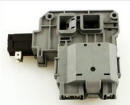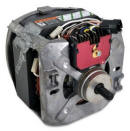Washer Not Spinnning
The spin cycle is used to move more water from the clothes than
just draining the water out. The faster a washer spins, more
water is removed from the clothes. This also has a benefit of
cutting down on the amount of time your dryer has to run to remove
the moisture from the clothes and dry them.
Most Kenmore / Whirlpool style washers have a coupler that
connects the motor to the transmission. Most every other brand
has a belt that spins the wash tub during the spin cycle.
Here are some things to check when you have a washer that is not
spinning.
 Lid Switch
Lid Switch
This would be the first thing you always check when your washer
is not spinning. The washer will think the lid is open and not
spin. This is a safety feature to prevent you from breaking
your arm if you reach in the tub while the washer is spinning.
A common complaint for a bad lid switch is, "my washer is full of
water and won't spin".
There are two parts to the lid switch that make it work.
One is the actuator. These are located on the lid itself.
This is what presses down on the lid switch to activate it and tell
the washer that the lid is closed. Make sure your actuator is
not loose or broken.
The switch itself is located on the washer. It usually sits
behind a little hole that the actuator goes into. Most have a
paddle that moves up and down as the lid is opened and closed.
Sometimes the lever on the switch wears out and hangs too low for the
pin to push. This is a result of a cracked lid switch housing. When
you look into the hole the pin goes into, the lever of the lid switch
should completely block you from seeing in the hole. If you take a flat
head screwdriver and push on the lever through the hole, you should be
able to hear a tiny clicking sound every time you push it. Sometimes the
arms on the lid switch will break completely off.
Testing the Lid Switch - Whirlpool and Kenmore Washers
Video for Testing Whirlpool and Kenmore Lid Switches
To Test this style of switch is rather easy. First you must accessWhirlpool
and Kenmore Lid Switch the plug under the control panel that connects the switch
to the wiring harness. Watch this video on getting under the control area. Once
you locate the plug for the lid switch you will see 3 wires going to it. Unplug
the switch from the wiring harness. Test the two grey wires for continuity when
the lid is closed. You are testing the plug on the cabinet of the washer. If the
switch shows an open circuit when the lid is shut then the switch is bad.
How to Bypass a Washer's Lid Switch
 Door Lock Assembly
Door Lock Assembly
The door lock assembly is what is used on a front load washer.
This will lock the door and not allow you to open it until the tub
has stopped spinning. There is a solenoid inside the lock that
activates when the washer is in a spin cycle. Also there is a
microswitch inside the lock assembly that tells the washer that the
door is closed so the washer knows it's safe to spin. Most of
the time you can hear a door lock and unlock, this is the solenoid
moving back and forth.
 Motor Coupler
Motor Coupler
This is what's commonly known as the Direct Drive. When the coupler
breaks, the motor is unable to spin the transmission. The washer will
still drain because the water pump is connected directly to the motor
on the opposite end as the coupler. When this is broken, a common
complaint is, "My washer drains, but it won't spin". Checking the
coupler on this type of machine is simple. You can see it from under
the machine. Tilt the washer back and rest it against the wall. Look
up under the bottom and locate the motor. Now look between the motor
and the transmission. That is the location of your coupler.
 Bad Motor
Bad Motor
A washer will not spin if the drive motor is defective.
Washer motors are capable of spinning at different speeds and in
both directions. This is how your washer can have multiply
spin speeds and agitation speeds. It is possible for a single
direction and speed to go out. That means your washer can spin
on high, but not low. This can be tricky to diagnosis.